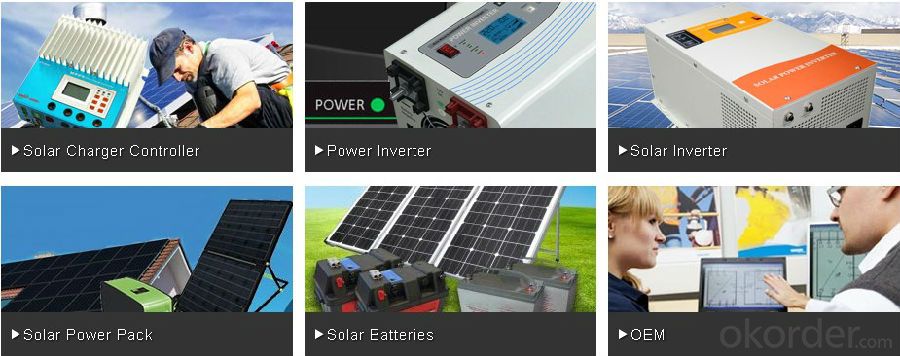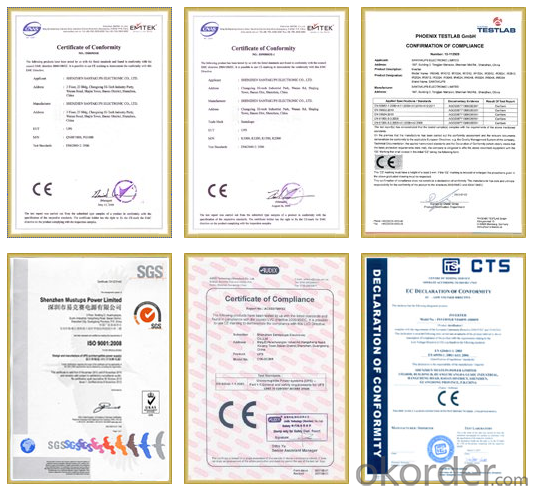Pwm/mppt Solar Inverter1000W -6000W Reliable
- Loading Port:
- China main port
- Payment Terms:
- TT OR LC
- Min Order Qty:
- 100 pc
- Supply Capability:
- 1000 pc/month
OKorder Service Pledge
OKorder Financial Service
You Might Also Like
Pwm/mppt Solar Inverter1000W -6000W Reliable
Features :
1. High overload ability of our EP3200 charger is up to 300% rated power
2. EP3200 pure sine wave inverter adopts low quiescent current, and power saver mode to reduce power consumption to 3W . It can extract max. power from various batteries with different protections, and low voltage trip can be selected (10V/10.5V/11V).
3. Uses PFC (power factor correction) for charger, which has less power consumption than conventional units.
4. It has 10s delay before transfer when AC resumes, and overload protection when our APC pure sine wave inverter equips with generator.
5. 10ms typical transfer time between battery and AC, which guarantees power continuity of EP3200 charger. Uses selectable input AC voltage (185-265V or 155-255V) for different kinds of loads.
Specification:
| Rated Capacity | 4000W | 5000W | 6000W | |
| Efficiency | >90% | |||
| Input | ||||
| Model | 120v Models | 230v Models | ||
| Nominal Voltage | 100V/110V/115V/120VSelectable | 200V/220V/230V/240V Selectable | ||
| Output | ||||
| Rated Power | 4000W | 5000W | 6000W | |
| Output Voltage | 100V/110V/115V/120V Selectable | 200V/220V/230V/240V Selectable | ||
| Voltage Waveform | Pure Sine Wave | |||
| Crest Factor | 3:1 | |||
| Transfer Time | Transfer Time : AC To DC : 10ms (Typical) Transfer Time : DC To AC : 10ms(Typical ) | |||
| Max Bypass Overload Current | 30A | |||
| Input | ||||
| Nominal Voltage | DC24V/48V | DC48V | DC48V | |
| Over Current Protection | By Re-Settable Over Current Protector | |||
| Output | ||||
| Regulation (Nominal) | ±10% Typical Of Nominal Voltage | |||
| Nominal Input Voltage | 230Vac | |||
| Input Voltage Range | 185-265Vac | |||
| Nominal Output Voltage | According To The Battery Type | |||
| Nominal Charge Current | 30Amp-70Amp | |||
| Battery Type | Lead-Acid 12Ah ~ 250Ah | |||
| Typical Backup Time | No Limit | |||
| Charging Method | Smart Pulse Charging With Two Charging Modes: Quick Charging When Battery Is Not Fully Charged, Trickle Charging When Battery Is 90% Fully Charged. | |||
| Average Charging Current | 65A/35A | 70A/40A | 50A | |
| Battery Voltage options | ||||
| Options 7 | Battery low trip to bypass 11v , high trip to battery 14v | |||
| Options 8 | Battery low trip to bypass 10.5v , high trip to battery 13.5v | |||
| Options 9 | Battery low trip to bypass 10v , high trip to battery 13v | |||
| Communications & Management | ||||
| Control Panel | LCD/LED Option | |||
| Audible Alarm | Alarm On Battery: Low Battery & Battery Over Voltage Alarm On Abnormal Operation: Over Load, Short-Circuit, & Over Heat | |||
| Environment And Safe | ||||
| Operating Temperature | 0℃ To 40℃ (32℉ To 104℉) | |||
| Transit/Storage Temperature | -15℃ To 60℃ | |||
| Audible Noise | 60 Dba Max at 1m | |||
| Quality Control System | ISO 9001,FCC,CE | |||
| Physical | ||||
| Dimensions: (H×D×W) | 755*320*310mm | |||
| G.W (Kg) | 37.5 | 47.5 | 47.5 | |
| Packing | Export Carton For Each Unit Per Carton | |||



Warrenty
provides a 1~3 year limited warranty (“Warranty”) against defects in materials and workmanship for its Uninterruptible power supply, Power inverter/chargers, Solar charge controllers, Battery Products (“Product”).
The term of this Warranty begins on the Product(s) initial purchase date, or the date of receipt of the Product(s) by the end user, whichever is later. This must be indicated on the invoice, bill of sale, and/or warranty registration card submitted to MUST-Solar. This Warranty applies to the original MUST-Solar Product purchaser, and is transferable only if the Product remains installed in the original use location.
FAQ
1. How fast will my system respond to a power outage?
Our solar inverters typically transfer to battery power in less than 16 milliseconds (less than 1/50th of a second).
2. What kind of batteries do the systems include?
Our solar backup electric systems use special high-quality electric storage batteries.
3. How do I install my system?
A solar backup inverter is connected to a home electric system , we will supply detailed installation manual and videos for our customers .
- Q:How does a solar inverter protect against short circuits?
- A solar inverter protects against short circuits by incorporating protective devices such as fuses or circuit breakers in its design. These protective devices are designed to detect high current flow caused by a short circuit and quickly interrupt the circuit, preventing any damage or overheating that could occur. Additionally, advanced solar inverters may also include built-in monitoring systems that constantly monitor the electrical parameters and shut down the inverter in case of a short circuit to ensure safety and prevent further damage.
- Q:How does a three-phase solar inverter differ from a single-phase inverter?
- A three-phase solar inverter differs from a single-phase inverter in terms of the number of phases they support. While a single-phase inverter is designed to work with a single-phase electrical system, a three-phase solar inverter is specifically designed to handle three-phase electrical systems. This means that a three-phase inverter can handle higher power loads and is more efficient in distributing power across the three phases, resulting in better overall performance and stability for three-phase electrical systems.
- Q:What is the role of a remote monitoring system in a solar inverter?
- The role of a remote monitoring system in a solar inverter is to allow for real-time monitoring and management of the solar power generation and inverter performance from a remote location. It provides valuable insights into the system's efficiency, troubleshooting capabilities, and helps ensure optimal performance and timely maintenance. Additionally, a remote monitoring system allows for data analysis, performance tracking, and can facilitate predictive maintenance to maximize the overall efficiency and longevity of the solar inverter system.
- Q:Can a solar inverter be used in areas with unstable power grids?
- Yes, a solar inverter can be used in areas with unstable power grids. Solar inverters are designed to convert the direct current (DC) produced by solar panels into alternating current (AC) that can be used to power homes or businesses. In areas with unstable power grids, the solar inverter can help stabilize the electricity supply by converting the solar energy into usable AC power, independent of the grid's stability. Additionally, some advanced solar inverters come with features like grid-tie functionality, battery storage, or grid support functions that further enhance their ability to adapt to unstable power grids.
- Q:What is the role of a power control feature in a solar inverter?
- The role of a power control feature in a solar inverter is to regulate and optimize the flow of electricity from the solar panels to the electrical grid or to the connected devices. It ensures that the power generated by the solar panels is converted and delivered efficiently, while also monitoring the voltage and frequency levels to maintain a stable and reliable power supply. Additionally, the power control feature enables the inverter to synchronize with the grid and comply with local regulations and requirements.
- Q:Can a solar inverter be used with solar-powered irrigation systems?
- Yes, a solar inverter can be used with solar-powered irrigation systems. The solar inverter converts the direct current (DC) produced by the solar panels into alternating current (AC) that can be used to power the irrigation system. This allows for the efficient and effective utilization of solar energy in irrigating crops or plants.
- Q:What is the maximum short-circuit current that a solar inverter can handle?
- The maximum short-circuit current that a solar inverter can handle depends on its specific design and specifications. It varies from one model to another, but typically, solar inverters are designed to handle short-circuit currents within the range of 10 to 25 times their maximum continuous output current. However, it is crucial to consult the manufacturer's guidelines or product specifications for the exact maximum short-circuit current rating of a specific solar inverter model.
- Q:What is the role of power factor correction in a solar inverter?
- The role of power factor correction in a solar inverter is to improve the efficiency and stability of the system by minimizing the reactive power and optimizing the power factor. This ensures that the inverter operates at its highest efficiency and reduces any voltage drops or disturbances in the grid. Additionally, power factor correction helps to comply with grid regulations and standards, preventing penalties and ensuring smooth integration of solar power into the electrical grid.
- Q:What is the role of reactive power control in a solar inverter?
- The role of reactive power control in a solar inverter is to manage and optimize the flow of reactive power between the solar PV system and the grid. This control allows the inverter to regulate the power factor, which is the ratio of real power to apparent power, ensuring that the system operates efficiently and in compliance with grid requirements. By adjusting the reactive power output, the inverter can compensate for voltage fluctuations and stabilize the grid, improving the overall performance and reliability of the solar power generation system.
- Q:Can a solar inverter be used in a solar-powered desalination system?
- Yes, a solar inverter can be used in a solar-powered desalination system. A solar inverter is responsible for converting the DC (direct current) output from solar panels into AC (alternating current) electricity that can be used to power various devices. In a solar-powered desalination system, the solar inverter would play a crucial role in converting the DC power generated by the solar panels into the AC power necessary to operate the desalination equipment, thereby enabling the system to function efficiently.
1. Manufacturer Overview |
|
|---|---|
| Location | |
| Year Established | |
| Annual Output Value | |
| Main Markets | |
| Company Certifications | |
2. Manufacturer Certificates |
|
|---|---|
| a) Certification Name | |
| Range | |
| Reference | |
| Validity Period | |
3. Manufacturer Capability |
|
|---|---|
| a)Trade Capacity | |
| Nearest Port | |
| Export Percentage | |
| No.of Employees in Trade Department | |
| Language Spoken: | |
| b)Factory Information | |
| Factory Size: | |
| No. of Production Lines | |
| Contract Manufacturing | |
| Product Price Range | |
Send your message to us
Pwm/mppt Solar Inverter1000W -6000W Reliable
- Loading Port:
- China main port
- Payment Terms:
- TT OR LC
- Min Order Qty:
- 100 pc
- Supply Capability:
- 1000 pc/month
OKorder Service Pledge
OKorder Financial Service
Similar products
New products
Hot products
Hot Searches
Related keywords
































